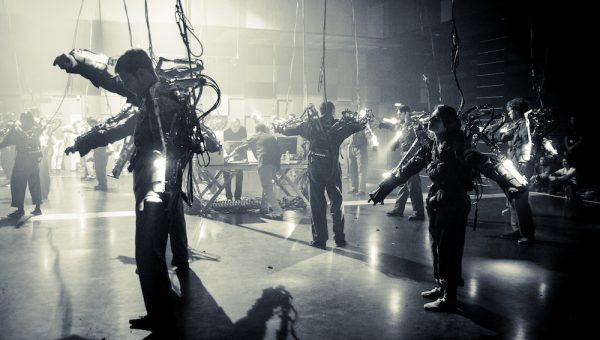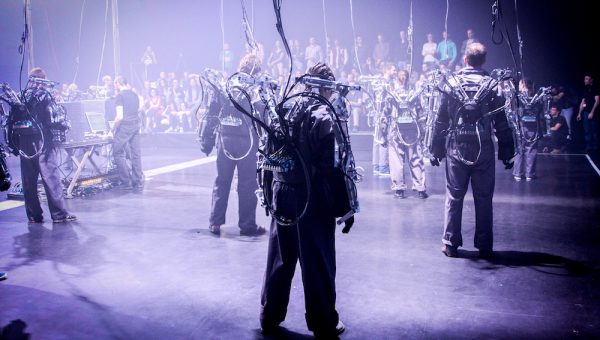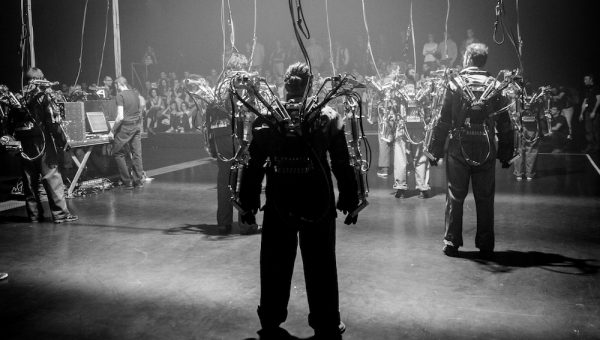Meta.Morf 2018 – A Beautiful Accident
LOUIS-PHILIPPE DEMERS (CA) / BILL VORN (CA) – Dokkhuset /
March Friday 9 & Saturday 10, 2018 @ 21.00! – Tickets NOK 200/100.
Order tickets HERE for Friday the 9th, and HERE for Saturday the 10th! – Limited spectator seats!
NB! FREE ENTRANCE if you sign up for being part of the performance!
Get dressed up in an exoskeleton suit that controls your body movements and become a robot for 20 minutes!
Each concert lasts one hour, and each signed up performance participant is part of the perfomance for a period of max 20 minutes.
— Send an email to teks@teks.no to sign up for free! —
INFERNO
Inferno from Louis-Philippe Demers on Vimeo.
Photos: Magalie Fonteneau
INFERNO is a robotic performance project inspired by the representation of the different levels of hell as described in Dante’s Inferno or the Singaporean Haw Par Villa’s Ten Courts of Hell (which is based on a Chinese Buddhist representation). In Inferno, the “circles of hell” concept is mainly an artistic framework, a general working theme under which the different parts of the performance will be regrouped. It is observed that under these two cultural representations, each “level of hell” corresponds to a particular form of punishment for a particular sin. In the many depictions of Hell, the punishments are always carried on the human body and not directly at the psychological level. The excruciating pain and also the eternal aspect of the punishment induces the latter.
The specificity of this performance project resides in the fact that the different machines involved in the show will be installed on the viewers’ body. The public will then become an active part of the performance. Depending of the kind of mechanism that they will be wearing, the viewers will be free to move or they will be in a partial or entire submission position, forced by the machines to act/react in a certain way. Some mechanical structures will coerce the viewers in performing certain movements; others will induce a physical reaction from them.
During the performance, the symbiotic robots will certainly not induce pain but rather invoke a bodily experience that entails the eternal process of the punishment. The establishment of a subsumed body at the mercy of an invisible punisher chimes with our anxiety of the utopian or dystopian views of our existences under the control of a machine. As David Tomas2 observes on Weiner, Cybernetics is a world of automatic machines under the common denominator of “control and communication”. Organisms are shifted from biology to engineering transforming them into hardware (software) models. Inferno translates the automation of control and communication into an apparent infinite process of sins and punishments.
Louis-Philippe Demers makes large-scale installations and performances. His projects can be found in theatre, opera, subway stations, art museums, science museums, music events andtrade shows. Over the past two decades, he participated in more than seventy artistic and stage productions and has built more than 375 machines. Demers¹ works have been featured at major venues such as Theatre de la Ville, Lille 2004, Expo 1992 and 2000, Sonambiente, ISEA, Siggraph and Sonar. He received six mentions and one distinction at Ars Electronica, the first prize of Vida 2.0, mentions at Vida 12.0 and 15.0, two jury recommendations at the Japan Media Arts Festival, the Interactive prize for Lightforms 98 and six prizes for Devolution including two Helpmann Awards. Demers was Professor of Digital Media and Exhibit Design/Scenography at the Hochschule für Gestaltung Karlsruhe, affiliated to the world renowned Zentrum für Kunst und Medientechnologie (ZKM, Germany). Since he joined the Interaction and Entertainment Research Centre and the newly founded School of Art, Design and Media at the Nanyang Technological University.
http://www.processing-plant.com

Bill Vorn
http://billvorn.concordia.ca/menuall.html

Based in Montreal, Bill Vorn is working in the field of Robotic Art since more than twenty-five years. His installation and performance projects involve robotics and motion control, sound, lighting, video and cybernetic processes. He pursues research and creation on Artificial Life and Agent Technologies through artistic work based on the “Aesthetics of Artificial Behaviors”.
He holds a Ph.D. degree in Communication Studies from UQAM (Montreal) for his thesis on “Artificial Life as Media”. He teaches Electronic Arts in the Department of Studio Arts at Concordia University (Intermedia program) where he is Full Professor.
His work has been presented in many international events, including Ars Electronica, ISEA, DEAF, Sonar, Art Futura, EMAF and Artec. He has been awarded the Vida 2.0 award (1999, Madrid), the Leprecon Award for Interactivity (1998, New York), the Prix Ars Electronica Distinction award (1996, Linz) and the International Digital Media Award (1996, Toronto). He has worked in collaboration with many canadian artists (including Edouard Lock, Robert Lepage, Gilles Maheu, Istvan Kantor and Louis-Philippe Demers). He was cofounder of the electronic pop music band Rational Youth with Tracy Howe in 1981.

















